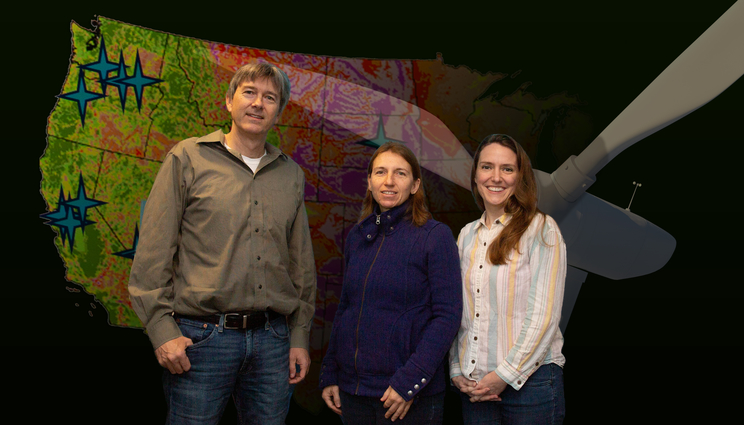Three researchers co-author wind power papers
 (Download Image)
(Download Image)
Three LLNL researchers have co-authored three separate papers about projects they’ve worked on to improve wind power forecasting for the country. They are, left to right, Jeff Mirocha, Sonia Wharton and Katie Lundquist. Photo by Julie Russell/LLNL.
A trio of Livermore scientists have served as co-authors for three separate papers about projects they’ve worked on to upgrade wind power forecasting for the nation.
The papers, published by the Bulletin of the American Meteorological Society (BAMS), one of the premier publications for meteorologists, focused on research conducted for two high-impact Department of Energy wind energy projects: the Wind Forecast Improvement Project (WFIP2) and the Mesoscale-to-Microscale Coupling (MMC) project.
The WFIP2 project consisted of an 18-month field campaign (October 2015 to March 2017) in which a network of meteorological instruments were placed from the Pacific Ocean coastline to eastern Oregon and Washington to gather observations of the wind field, as well as information about temperature, pressure, solar radiation and moisture in the lower atmosphere.
As part of the field campaign, LLNL furnished two of its vertical profiling Light Detection and Ranging (LIDAR) instruments that were used to gather continuous data on wind speeds and direction from the ground to 150 meters high. These heights include all possible wind altitudes that a modern wind turbine would encounter.
“The primary goal of the project was to improve and validate atmospheric models for forecasting wind energy in complex terrain,” said Sonia Wharton, a Lab atmospheric scientist in the Atmospheric, Earth and Energy Division.
Wharton’s article, “The Second Wind Forecast Improvement Project: Observational Field Campaign,” included co-authors from three other national labs (Argonne, Pacific Northwest and the National Renewable Energy Laboratory) as well as the National Oceanic and Atmospheric Administration and universities. It appeared as the cover story in the September BAMS magazine.
An article co-authored by Katie Lundquist and entitled, “Improving Wind Energy Forecasting Through Numerical Weather Prediction Model Development,” was published in the November BAMS edition. Lundquist is a mechanical engineer in the Lab’s Computational Engineering Division.
“Weather models have historically been used to model large-scale weather events, such as storms,” Lundquist said. “But they have deficiencies at modeling wind speed and direction at wind turbine heights.
“We implemented model improvements to better predict wind resources for turbines. The model improvement resulted in a reduction of the error on power forecasting in the range of 5 percent to 12 percent. We feel like this is an important advance,” Lundquist added.
The third paper, “On Bridging a Modeling Scale Gap: Mesoscale to Microscale Coupling for Wind Energy,” was co-authored by Jeff Mirocha, an atmospheric scientist in the Atmospheric, Earth and Energy Division.
Mirocha’s paper, which is expected to appear within the next month in BAMS, discusses the importance of changing weather conditions and environmental impacts on wind power production within a wind farm.
“We generally use different types of models for weather and for wind farm power forecasting because of the different geographical scales,” Mirocha said. “Information is not easily exchanged between the different models and spatial scales, but that exchange of information is critical to improve wind power forecasting.”
The paper describes new methods under development by the researchers to bridge the gap between the mesoscale and the microscale.
“When a weather system moves through a wind farm, it causes large changes in power production, with major upswings or downswings,” Mirocha said.
In Mirocha’s view, the two projects – the WFIP2 and the MMC effort – fit together well. “The WFIP2 collected data over different geographical scales that can be used by the MMC project to improve modeling both within and across those scales,” he explained.
Contact
 Stephen Wampler
Stephen Wampler
[email protected]
(925) 423-3107
Related Links
Bulletin of the American Meteorological SocietyWind Forecast Improvement Project
Mesoscale-to-Microscale Coupling
Tags
Physical and Life SciencesFeatured Articles







